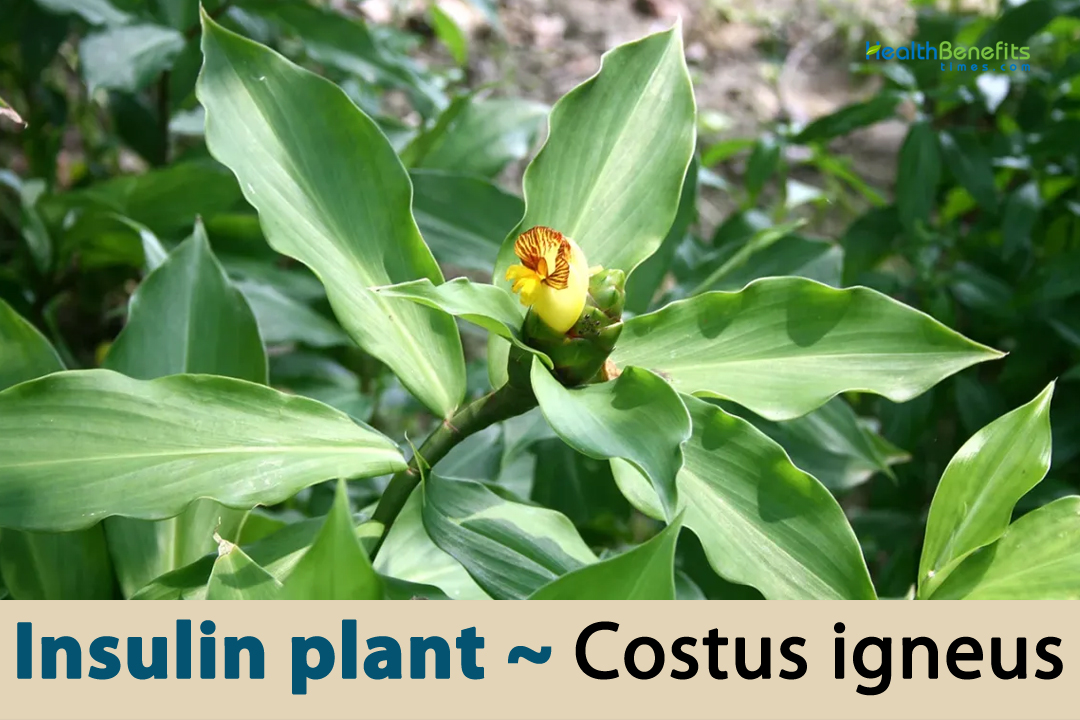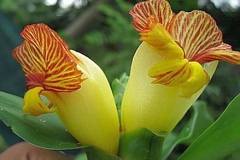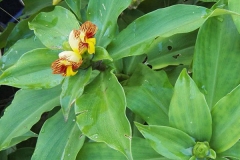| Insulin plant Quick Facts | |
|---|---|
| Name: | Insulin plant |
| Scientific Name: | Costus igneus |
| Origin | Tropical regions of Southeast Asia |
| Colors | Green |
| Shapes | Fruits are less than 0.5 inches in diameter, and unremarkable. |
| Major nutrients | • Protein • Terpenoids • Flavonoids • Antioxidants • Ascorbic Acid • Iron • B Carotene • Corosolic Acid and others |
| Health benefits | Diabetes, Digestion, Kidney Health, Liver Illness, Bladder Health, Boosts Immunity, Prevents Cancer, Cures Asthma, Reduces Blood Pressure, Reduce Bronchitis Symptoms, Treats Fever, Skin diseases, Weight loss |
| Name | Insulin plant |
|---|---|
| Scientific Name | Costus igneus |
| Native | Tropical regions of Southeast Asia, specifically on the Greater Sunda Islands in Indonesia and in Africa, South and central America |
| Common Names | Fiery Costus, Spiral flag, Insulin plant, Step ladder, Spiral Ginger, Spotted Spiral Ginger, Painted Spiral Ginger, Flaming costus and Banaba |
| Name in Other Languages | Assamese: Inaculina gacha (ইনচুলিন গছ) Bengali: Piasal Dutch: Costus igneus English: Fiery costus, Flaming costus, Insulin plant, Spiral flag, Step ladder, Banaba, Spiral Ginger, Spotted Spiral Ginger, Painted Spiral Ginger Finnish: Kostus Hindi: Baanda, Bija-sal, Peisar, Jarul, Keukand. German: Kostwurz Gujarati: Pakarmula Kannada: Kemou honne Malayalam: Honne, Karintakara, Vengai, Venna-maram, insulin chedi (ഇൻസുലിൻ ചെടി) Marathi: Honi, Pushkarmula Persian: کامائکستوس Odisha: Vengis. Sanskrit: Asana, Bandhukapushpa, insulin Siddha: Kostum Tamil: Neyccarikamaram, Venkal-c-ciray, Kostam, Kostum. Telugu: Cengalva kostu, Peddavesiga, Yeangesha, Kāsṭas igneyas (కాస్టస్ ఇగ్నెయస్) Urdu: Bijasar, Bam al akhwain, Dam al akhwain Other: Kostum, Sumbul chi khat |
| Plant Growth Habit | Perennial, upright, spreading tropical evergreen plant |
| Growing Climates | Tropical and subtropical rainforests, home gardens, agricultural lands, edges of forests and clearings and riverbanks |
| Soil | Well-drained, loamy to sandy soil and rich in organic content, poor drainage can lead to root rot. Slightly acidic to neutral pH range of 6 to 7 for optimal growth |
| Plant Size | 2–3 meters |
| Leaf | Leaves are simple, alternate, entire, oblong, 4-8 inches long with parallel venation, spirally arranged around the stems. Large, fleshy, smooth, and dark green leaves have a light purple underside |
| Flowering season | Between May and September, depending on their location |
| Flower | Yellow to orange, 1.5 inches in diameter, on cone-like head at the tips of branches |
| Fruit Shape & Size | Fruits are less than 0.5 inches in diameter, and unremarkable |
| Fruit Color | Green colored |
| Plant Parts Used | Leaves, roots, stem |
| Propagation |
|
| Varieties |
|
| Major Nutrition |
|
| Health benefits |
|
| Available Forms |
|
Plant Description
The insulin plant is an upright, spreading, perennial tropical evergreen that typically reaches a height of 2–3 meters. Tropical and subtropical rainforests, residential gardens, agricultural lands, forest margins, clearings, and riverbanks are all habitats for this plant. The plant thrives in organic-rich, well-drained loamy to sandy soil; inadequate drainage can result in root decay. A pH range of 6 to 7, which is slightly acidic to neutral, is ideal for optimal growth. The plant’s catchphrase is “A daily leaf prevents diabetes.” It is predominantly cultivated as an ornamental plant in southern India, and its leaves are employed as a dietary supplement for the management of diabetes mellitus.
It is a common ornamental plant in South Indian gardens and is also found in many untamed areas. In India, it is utilized to regulate diabetes, and diabetics are known to consume one leaf per day in order to maintain a low blood glucose level. The tribal inhabitants of the Namakkal district in Tamil Nadu’s Kolli highlands utilized leaves as one of several well-known plants for the treatment of diabetes.
Leaves
The simple, alternate, entire, lanceolate, evergreen leaves measure 4 to 8 inches in length and are venated in a parallel fashion. This tropical evergreen has light purple undersides on its sizable, smooth, dark green leaves, which are spirally arranged around stems to create attractive, arching clumps that emerge from underground rootstocks. It is contraindicated for expectant or nursing women to consume this leaf.
Flowers
Produced during the mild months, the flowers have a diameter of 1.5 inches and range in color from yellow to orange. They manifest as cone-shaped heads atop the branches. Flowering takes place from May to September, the exact timing of which varies by location.
Fruits
The fruits are green in color, less than 0.5 inches in diameter, and unremarkable.
Care for Insulin Plant
- Maintain the plant in direct or indirect natural sunlight.
- Use a finger or a small tool to prod the soil in order to determine its moisture content.
When the topsoil (1-2 inches) becomes desiccated to the touch, water it. - Repot the plant at least two weeks after receiving it.
- It should not be overwatered.
- Reduce watering during the winter and wet seasons while extensively watering during the summer.
- It is recommended to let the soil evaporate completely between watering.
- It is advisable to supplement the soil with fertilizers and plant feed prior to tree sowing.
- The organic fertilizer can be applied.
- Once per month throughout the primary growing season (August to December), apply organic fertilizer to the plant.
- Irrigate the topsoil so as not to disrupt the plant’s roots, thereby facilitating enhanced absorption of nutrients and moisture.
- Dispose of any plant parts that are deceased, infected, or damaged in a location separate from the plants.
- As initial treatment for any insect infestation or disease, a spray containing neem oil, eucalyptus oil, or citrus oil may be utilized.
Types of Insulin Plant
- Costus igneus var. spiralis: The spiraling leaves of this particular variety contribute to the captivating aesthetic allure of the plant. Its health benefits are comparable to those of the common insulin plant variety.
- Costus igneus var. compactus: This insulin plant variety exhibits a more compact growth habit and smaller foliage. It is an appropriate choice for individuals who have restricted living space.
- Costus igneus var. Albus: White leaves distinguish this variety of insulin plant from the norm, which are green. Similar in nature to its medicinal attributes, it has the potential to captivate and enhance any horticultural setting.
Health Benefits of Insulin Plant
Multiple studies demonstrate that insulin leaves are rich in fructose, an essential component for digestion. Exorbitant fructose is absorbed and filtered by a digestive enzyme in the human body; this process returns the blood sugar level to normal. Here, several significant health benefits of insulin leaves have been discussed.
1. Diabetes
The herb’s name suggests that insulin plants are widely used to treat diabetes through their ability to efficiently lower blood sugar levels. Fructose, which is found in the leaves of the insulin plant, controls the elevation of blood glucose levels. Extremely hazardous are elevated blood sugar levels, which can hamper nutrient delivery to the body and cause organ dysfunction.
Consistent ingestion of insulin leaves can assist in the prevention of these health complications as well as chronic diseases. Diabetes can typically be effectively managed with a single administration of insulin plant leaves, as supported by over 15 clinical studies. Using insulin leaves to prepare a decoction is the most effective method of treating diabetes. Burn for ten minutes a few leaves of the insulin plant. This water should be strained and consumed twice daily for optimal results. An investigation has demonstrated the utility of insulin plant foliage.
2. Reduce Cholesterol Level
Not only do the leaves of the insulin plant decrease blood sugar levels, but they also have a significant effect on them. When these leaves are consumed by a diabetic patient, their cholesterol level decreases. This is due to the high water and water-soluble content of the insulin plant, which inhibits the absorption of glucose from the digestive tract into the circulation. It will improve lipid absorption and assimilation, thereby decreasing the body’s blood cholesterol level.
Elevated levels of blood cholesterol have been associated with an increased likelihood of developing stroke, myocardial infarction, or malignancy. Cholesterol is a significant threat to human health, and the most effective method to prevent it is by consuming insulin plant. Consistent ingestion of insulin plant leaves will result in the hydrolysis of dietary cholesterol.
3. Better Digestion
The insulin plant is composed of numerous micronutrients and intricate compounds. The functionality of those constituents is beneficial for E. coli bacteria, which are beneficial intestinal bacteria. It contributes to the efficient operation of the digestive system in humans. Furthermore, it facilitates the optimal assimilation of nutrients contained in the food.
Additionally, the insulin plant leaves contain a substantial quantity of fructose, a compound that aids in the enhancement of colonic function. The elimination process of insulin can be facilitated through the consumption of insulin plant leaves. It is advised to consume a decoction of one to two insulin plant leaves orally after each meal for a continuous period of one month.
4. Antioxidant Property
It is universally recognized that oxidation is an inherent chemical process that generates free radicals. Cancer is one of the severe health problems that may result from the radicals’ degradation into body cells. People are therefore attempting to eliminate free radicals, as they are detrimental to human health and epidermis health.
Insulin plants contain a moderate quantity of antioxidants, which is particularly advantageous for individuals with diabetes. It is capable of reversing the oxidative stress induced in the kidney, liver, and pancreas by diabetes. Antioxidant content in the insulin plant is approximately 90%. Through consistent ingestion of the leaves of the insulin plant, the body can counteract oxidation and overcome the cellular oxidation process.
5. Antibacterial Property
The insulin plant possesses potent antibacterial properties that are effective against a wide variety of gram-positive bacteria. Individuals who experience difficulty with the urinary process may benefit from consistent ingestion of these leaves. The extract of insulin leaves will eradicate the harmful microorganisms in the urinary tract. Additionally, it improves relief and autonomously regulates the excretory system, but it requires a substantial amount of water for extraction.
6. Maintains Kidney Health
The renal issue originates with a renal infection and progresses to renal calculi, culminating in renal dysfunction. After experiencing a kidney malfunction, it is impossible to return to normalcy. Therefore, blood-washing is necessary for your continued existence.
The diuretic effect of the leaves and rhizomes of the insulin plant regulates sodium and potassium clearance, thereby impacting diuresis. A balanced rate of automatic excretion and appropriate diuresis can help enhance kidney health. Individuals who are afflicted with kidney infections or kidney stones may incorporate insulin leaf tea into their daily routine as it has been shown to enhance renal function.
7. Cures Liver Illness
The majority of liver diseases are brought on by lipid accumulation in the liver, which can result in chronic conditions. Excessive body obesity contributes to an unhealthy way of life, which increases the susceptibility to particular health issues, such as cancer. Several essential components found in the leaves of the insulin plant aid in the breakdown of fatty acid accumulation in the liver and enhance liver function.
Individuals with liver issues may ingest insulin leaf drink a minimum of two to three times daily. The poison will subsequently dissolve in the liver.
8. Maintains Bladder Health
Numerous factors, including dehydration or a urinary tract infection caused by a virus, are capable of genesis bladder complications. Insulin plant diuretic compounds contribute to improved bladder health. Maintaining a healthy bladder is critical; failure to do so can result in severe infections.
Urination is regulated by the leafy extract of an insulin plant. It is beneficial to take it prior to bedtime because it ensures the bladder continues to function properly during the night and eliminates waste in a healthy manner in the morning.
9. Boosts Immunity
The antioxidant property of insulin plant leaves stimulates the immune system automatically through the elimination of free radicals. Maintaining a robust immune system is essential for leading a healthy lifestyle.
A mixture of honey and insulin plant leaf extract can be consumed in the morning. A minimum of twice daily consumption will provide a modest boost to the immune system and safeguard the body against pathogens.
10. Prevents Cancer
“Prevention is preferable to treatment.” The ethanolic extract of the insulin plant possesses the highest concentration of anti-proliferative and anti-cancer properties, according to a study. This investigation substantiates the efficacy of this plant’s anti-cancer properties against A549 and HT 29 cells.
Regular consumption of the extract inhibits the development of cancer cells within the body. Cancer is frequently attributed to free radicals; therefore, the antioxidant properties of these leaves will protect the body from free radical toxicity.
11. Cures Asthma
Research has demonstrated that the insulin plant possesses anti-inflammatory properties, thereby enabling it to regulate airway inflammation. Additionally, it provides solace to the constricted respiratory muscles that persist throughout an episode of asthma. Individuals who are afflicted with asthma attacks profit significantly from ingesting insulin plant leaves.
12. Reduces Blood Pressure
The consequences of hypertension are extremely hazardous. Hypertension can be fatal; it causes the heart to beat rapidly and forces the brain to suffer a stroke. The ingestion of this herb’s foliage will result in a reduction in blood pressure. Consuming the insulin leaf potion is an effective treatment for hypertension. Consuming insulin leaf potion is an effective treatment for hypertension.
13. Reduce Bronchitis Symptoms
Bronchitis is brought on by a constricted airway. This is due to the presence of inflammation and an excess of mucus in the airway. The insulin leaves contain essential compounds that exhibit potent anti-inflammatory properties in the treatment of inflammation. It diminishes airway edema and facilitates unrestricted ventilation. Daily consumption of the tea will aid in the reduction of inflammation and eventual resolution of bronchitis.
14. Used as a Sore Throat Therapy
Individuals suffering from a sore throat initially experience pain, followed by an irritating sensation within the throat. Sore throat is brought on by inflammation of the pharynx, which can result in influenza. A sore throat is extremely painful and makes it difficult to speak, consume, drink, and swallow. Daily and evening consumption of the heated insulin leaves will cause a gradual resolution of the sore throat.
15. Treats Fever
Fever is treated with insulin plant leaves according to Ayurveda. One leaf, when chewed in the morning, will provide immediate fever relief. Several studies have demonstrated that insulin plants possess antipyretic properties, allowing patients to recuperate rapidly from fever.
16. Skin diseases
The insulin plant possesses exceptional skin protection properties and is therefore applicable in the treatment of skin disorders. After applying the insulin plant leaf paste, permit it to cure. After that, cleanse your face. Over the course of two weeks, your skin will become more taut and radiant. An enhancement in the skin’s elasticity results.
17. Weight loss
Likewise, the insulin plant may be utilized as a natural remedy for weight loss. It is believed that the herb increases metabolism and aids in fat reduction. The compound found in the plant is known to promote a more accelerated lipid metabolism within the body. This practice promotes weight loss and serves as a preventive measure against obesity.
Ayurvedic Health benefits
- Its use as an herbal remedy for diabetes is gaining prevalence in the Philippines.
- It is used to treat diabetes in Siddha medicine; leaves are chewed twice daily, or 1/2 to 1 gram of dried leaf powder is consumed twice daily.
- Tribal inhabitants of the Kolli hills in Tamil Nadu use it to treat diabetes.
- A decoction derived from foliage and roots is employed to lower blood sugar levels in Mizoram, India.
- The leaves are utilized for the treatment of diabetes, skin ailments, asthma, bronchitis, fever, and intestinal worm disease in west Sikkim, India.
- Aerial component infusions are utilized to treat renal disorders in Mexico.
- During the initial week, the patient is instructed to consume two leaves in the morning and two leaves in the evening.
- Within the realm of Indian Traditional Medicine, this botanical specimen is employed for its purported ability to prolong life expectancy, alleviate skin ailments, lower fever, treat asthma and bronchitis, and eradicate intestinal worms.
- This plant is mentioned in traditional Indian literature as a component of a cosmetic intended for application on the eyelashes in order to enhance their appearance.
- The utilization of fresh leaves of the insulin plant functions as an inherent sugar regulator.
- It functions exceptionally well as a blood purifier and aids in the maintenance of clear, healthy skin.
- It aids in preventing parasitic invasions and eliminating worm infestations.
- It stimulates the liver, spleen, and pancreas and facilitates remarkable food absorption.
- The isolated population of cells responsible for secreting the hormone insulin is stimulated.
- It facilitates the provision of palliative care for uterine fibroid and PCOD and regulates women’s menstrual cycles.
Different Uses
- Culinary Uses: The leaves of the Insulin plant are utilized in cookery in some cultures. Incorporate them into smoothies, salads, or beverages. Particularly flavorful, the leaves’ mildly astringent flavor can be incorporated into dishes.
- Ornamental Plant: In addition to being cultivated as an ornamental plant in residences and gardens, the Insulin plant is favored for its attractive foliage and brilliant orange flowers. It enhances the visual appeal of both indoor and outdoor areas.
- Natural Sweetener: Consideration is given to utilizing the insulin plant as a natural sweetener in regions where sugar restriction is prevalent. When processed, its leaves can impart a pleasant taste while preventing an increase in blood glucose levels; therefore, it is appropriate for diabetics and individuals who are watching their sugar intake.
- Herbal Teas: Herbal teas made from the leaves of the Insulin plant are purported to offer numerous health benefits, including weight loss assistance, metabolism enhancement, and a tranquil influence.
- Insect Repellent: The Insulin plant is utilized by some communities as a natural insect repellent. To ward off insects, the plant’s leaves may be pulverized and applied topically or dispersed throughout the residence.
- Nutritional Supplement: Including vitamins, minerals, and antioxidants in high concentrations, the Insulin plant possesses a nutritional profile that qualifies it for potential use as a dietary supplement to promote overall health.
- Educational Tool: The insulin plant can be utilized as an illustrative case in academic environments to illustrate concepts such as medicinal plant cultivation, plant physiology, and the significance of biodiversity in the realms of health and medicine.
Side effects
- It may cause low blood sugar levels: Utilizing the insulin plant while on insulin or other diabetes medications could potentially result in hypoglycemia. This may result in hypoglycemia, a medical condition distinguished by extreme low levels of glucose in the blood.
- It may cause allergic reactions: Certain individuals might develop an allergy to the insulin plant. This is due to the fact that the plant contains histamine, a compound that can produce an allergic reaction in some individuals. An allergic reaction is characterized by exudation, dermatitis, and inflammation. If any of these symptoms appear following the use of the plant, discontinue use immediately and consult a medical professional.
- It may interact with certain medications: There is a possibility that the insulin plant could interact negatively with blood pressure medications, cholesterol-lowering medications, and diabetes medications. Therefore, it is essential to consult your physician prior to utilizing the plant if you are currently on any medication.
- It may cause stomach upset: In certain individuals, the insulin plant may also induce gastric discomfort. This is due to the presence of saponin, a compound found in the plant that has the potential to induce gastrointestinal distress.
References:
https://gd.eppo.int/taxon/CQTCU
http://www.stuartxchange.org/InsulinPlant
https://globalresearchonline.net/journalcontents/v54-2/10.pdf








